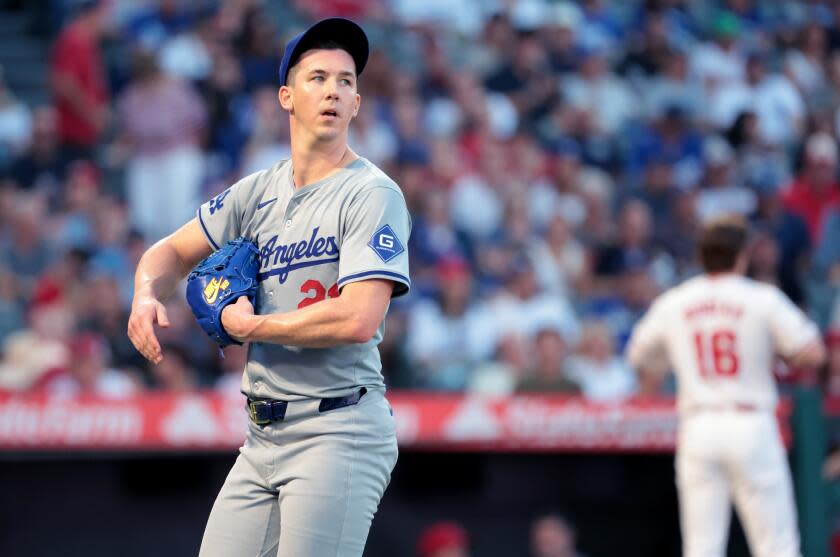
This time, they aren’t overthinking. This time, they don’t have a choice.
The Dodgers will start Yoshinobu Yamamoto in the opening game of their National League Division Series against the San Diego Padres on Friday but not necessarily because they trust him more than Jack Flaherty.
In the regular season, Yamamoto never once pitched a traditional five-day cycle. Flaherty did.
If the Dodgers stuck to their original plan of starting Flaherty in Game 1 and Yamamoto in Game 2, only Flaherty would be available to return for a potential Game 5. By trading their places in their rotation, both would be available, with one starting and the other pitching in relief.
The implication: The Dodgers know their bullpen could be completely spent by then.
Read more: Yoshinobu Yamamoto will start for Dodgers in Game 1 of NLDS vs. Padres
October is here, and the Dodgers once again have a starting pitching problem. Not even spending more than $500 million last winter could spare them their annual tradition of entering the postseason without any idea of what they will get from their rotation.
The Dodgers won more regular-season games than any team in the majors but are being talked about around the sport as if they’re underdogs in this NLDS. Starting pitching is why.
Yamamoto, their $325-million rookie import from Japan, has pitched only 16 innings in the last 3½ months. Flaherty, their prized trade deadline acquisition, experienced a noticeable decrease in fastball velocity in his last two regular-season appearances.
At this point, the most likely candidate to give them a quality start might be Walker Buehler. On the whole, the former All-Star hasn’t pitched well in his first season back from his second Tommy John operation, but he limited the Padres to one run in five innings in the Dodgers’ division-clinching victory last week.
Buehler is expected to start Game 3. The Dodgers are expected to resort to a bullpen game involving rookie Landon Knack if the series reaches Game 4.
This could be shaping into the same old story for the Dodgers. Their rotation might be a little better than it was last year and a little worse than it was two years ago, but they’re more or less in the same place they were when they were swept by the Arizona Diamondbacks at this stage of the postseason in 2023 and eliminated in four games by the Padres in 2022.
Asked about his assessment of his team’s pitching, president of baseball operations Andrew Friedman quickly shifted the conversation from the starters to the bullpen, which he called, “a real strength.”
“The more success we have in October, and for us to win 11 games [to win the World Series], I think our bullpen’s going to play a really important role in that,” Friedman said.
But how many innings can the innings cover?

Yamamoto has the highest ceiling on the starters, but he came down with an illness in recent weeks that affected his performance, resulting in shorter starts that kept him from getting stretched out as planned. In the four starts he made in September after returning from a midseason shoulder injury, the most he pitched in a game was five innings.
Flaherty averaged fewer than five innings in his last three starts. Buehler pitched one of his best games of the season against the Padres last week but his early removal was an indication of how the Dodgers now view him.
The Dodgers should be able to survive a best-of-five NLDS, especially with scheduled days off after Game 2 and 4 that will allow them to reset their bullpen. The NL Championship Series and World Series will be entirely different stories. In a seven-game series, Yamamoto or Flaherty, or maybe even both of them, will have to take down a significant number of innings for the team to have a chance. Someone will have to provide relief for the relievers.
How could the Dodgers find themselves in this position again? How could the Dodgers be in danger of wasting another historic offensive season because of a longstanding problem?
They could blame the injuries to their homegrown starters, including Gavin Stone and River Ryan. They could point to the underwhelming progress made by flamethrower Bobby Miller. Ultimately, however, they wouldn’t have the problems they have now if their big-ticket expenditures performed as expected. They invested $325 million in Yamamoto and $136.6 million in Tyler Glasnow, and the injury-prone Glasnow won’t even be available to pitch in these playoffs.
Read more: ‘Get them back.’ Dodgers look for redemption in NLDS rematch with Padres
Earlier this week, Friedman was in northern Japan to watch Roki Sasaki, the 22-year-old right-hander of the Chiba Lotte Marines.
Considered the country’s most promising talent since Shohei Ohtani, Sasaki has a 100-mph fastball and would be targeted by the Dodgers no matter what their situation. In their current state, Sasaki is a must-sign for them this winter, provided the Marines make him available.
Sasaki would be classified as an international amateur player if he moves to the majors this offseason, meaning he could only sign a minor-league contract. By joining a rotation that could also include Ohtani next season, he would represent a cost-efficient remedy for the team’s expensive mistakes.
But until the Dodgers sign Sasaki, or another upgrade, they will have to live with their mistakes. By now, the consequences are all too familiar.
Sign up for more Dodgers news with Dodgers Dugout. Delivered at the start of each series.
This story originally appeared in Los Angeles Times.
EMEA Tribune is not involved in this news article, it is taken from our partners and or from the News Agencies. Copyright and Credit go to the News Agencies, email news@emeatribune.com Follow our WhatsApp verified Channel



